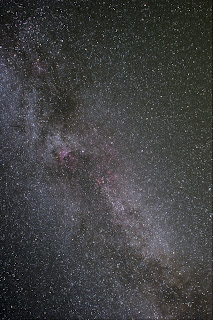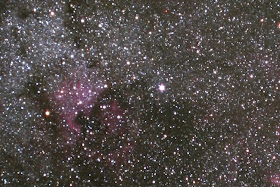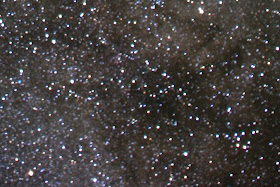 With a pretty significant glow to the east (Tucson and the new Border Patrol stop a few miles away), I shot west, of which most interesting was the constellation Cygnus the swan. Cygnus carries a bright section of the Summer Milky Way galaxy and contains a multitude of telescopic objects, but the wide field view is striking too. Of course, with a wide field, you can't enlarge it a huge amount to show telescopic objects. Realize that even with the lens wide open at F/2.8, the effective aperture of the 24mm focal length lens is only about 1/3 of an inch diameter or 8mm, so it is a pretty small telescope - only slightly larger than a fully dilated naked eye. This image is a stack of 10 exposures, about 45 minutes total exposure which were added together.
With a pretty significant glow to the east (Tucson and the new Border Patrol stop a few miles away), I shot west, of which most interesting was the constellation Cygnus the swan. Cygnus carries a bright section of the Summer Milky Way galaxy and contains a multitude of telescopic objects, but the wide field view is striking too. Of course, with a wide field, you can't enlarge it a huge amount to show telescopic objects. Realize that even with the lens wide open at F/2.8, the effective aperture of the 24mm focal length lens is only about 1/3 of an inch diameter or 8mm, so it is a pretty small telescope - only slightly larger than a fully dilated naked eye. This image is a stack of 10 exposures, about 45 minutes total exposure which were added together. But even with the lack of detail in the full image, it is fun to scroll thru the image and look for things that stand out. Seen immediately as I was "stacking" the exposures in the software, there was a extremely red star (near the top center edge) a few degrees north of Deneb(near the center of this exposure), the brightest star in the constellation. I was unaware of the "new" star, but when I pulled out my star maps, it was a well-known red carbon star called V Cygni (red star colors generally indicate very cool temperatures for stars, about 3,000F for carbon stars, the sun being about 5,800F). Also in this exposure is a very photogenic nebula called the North American Nebula because of it's familiar shape. It is a cloud of flourescing gas, mostly hydrogen, whose shape is also partially defined by dark clouds as well.
But even with the lack of detail in the full image, it is fun to scroll thru the image and look for things that stand out. Seen immediately as I was "stacking" the exposures in the software, there was a extremely red star (near the top center edge) a few degrees north of Deneb(near the center of this exposure), the brightest star in the constellation. I was unaware of the "new" star, but when I pulled out my star maps, it was a well-known red carbon star called V Cygni (red star colors generally indicate very cool temperatures for stars, about 3,000F for carbon stars, the sun being about 5,800F). Also in this exposure is a very photogenic nebula called the North American Nebula because of it's familiar shape. It is a cloud of flourescing gas, mostly hydrogen, whose shape is also partially defined by dark clouds as well. This other exposure is from near the very bottom of the full frame - is shows the bloating of the stars from optical defects at the edge of the wide field. Even so, at the left center edge, you can see the bluish green glow of the Dumbell Nebula (named for it's shape in a telescope, not it's discoverer!), and at the lower right, you can see the upside-down asterism of "the Coathanger" (Brocchi's Cluster).
This other exposure is from near the very bottom of the full frame - is shows the bloating of the stars from optical defects at the edge of the wide field. Even so, at the left center edge, you can see the bluish green glow of the Dumbell Nebula (named for it's shape in a telescope, not it's discoverer!), and at the lower right, you can see the upside-down asterism of "the Coathanger" (Brocchi's Cluster).I don't know if I'll keep the lens - many of these older lenses were designed for film and was likely considered a good performer, but the new digital sensors have stricter resolution requirements, so these errors start to show up. I've got a great performer in the Canon 10-22 zoom, but is pretty slow for astronomy at F/4.5 wide open, so more tests are needed. Gimme some more dark sky!
No comments:
Post a Comment
We value your comments, but no spammers, please!